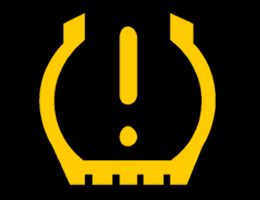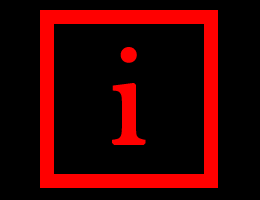Ford B-Max Dashboard Warning Lights
These are the dashboard warning lights for the Ford B-Max. The instrument cluster design and warning light location may vary depending on the year and location of your B-Max. Certain warning lights should illuminate when the ignition is switched on. If they do not illuminate, it indicates a malfunction. These warning lights are:
- Airbag
- Brake system
- Coolant temperature
- Doors open
- Engine warning light
- Frost warning
- Oil pressure
- Power steering
- Stability control
 Brake Warning Light
Brake Warning Light
If the red brake warning light does not illuminate with the ignition switched on or stays on while driving, immediate action is required. The Ford B-Max brake warning light comes on due to the following:
- Parking brake is applied
- Low brake fluid
- Brake system malfunction
If the brake light comes on while driving, check to ensure your parking brake is fully released. If it is, check brake fluid and top up if low. If the brake fluid is at the recommended level and the brake light remains on, it may indicate a malfunction with the brake system. It’s advised to stop driving and consult with a Ford workshop.

ABS Warning Light
ABS stands for Anti-lock Braking System and is an additional safety feature to normal brakes. If the ABS light comes on while driving, your normal brakes will continue to work but without the ABS. The usual cause for the Ford B-Max ABS light coming on is a faulty wheel speed sensor, though it can be a fault with the ABS module.

Coolant Temperature Warning Light
The Ford B-Max engine coolant warning light comes on when the engine is overheating. Stop the car when safely possible. Only add coolant when the engine is cold. If the engine is hot, wait 10 minutes for the engine to cool down. If the level is at the MIN mark or below, add coolant immediately. If the light comes back on, it may indicate a fault with the cooling system or a leak.

Engine Warning Light
The Ford B-Max engine warning light come on due to an engine fault, often related to the emissions control system. Common reasons for the Ford B-Max check engine warning light coming on, but not limited to are:
- Mass airflow sensor
- Oxygen sensor
- EGR valve (exhaust gas recirculation)
- Catalytic converter
- Blocked particulate filter
- Loose filler cap
If the engine warning light stays on steady, you can continue to drive the vehicle, but power may be reduced. If the engine warning light flashes, it may mean the engine is misfiring. A misfiring engine can cause damage to the catalytic converter. Avoid hard acceleration or high speeds. The only way to diagnose the fault is to have fault codes read using diagnostic equipment.

Powertrain Warning Light
The yellow cog containing an exclamation mark is the Ford B-Max powertrain warning light. Powertrain faults extend from anywhere in the engine, transmission, driveshaft etc. As with the engine warning light, diagnostic equipment is required to read fault codes. All good vehicle workshops have diagnostic fault code readers.
The powertrain and engine warning light may come on together. In this case, stop the vehicle as soon as possible and switch off the engine. The light may go off after a restart. You may experience a rough engine and reduced engine power.
Some versions of the Ford B-Max may have a spanner warning light / wrench symbol ![]() instead of the yellow cog. The spanner warning light is an alternative symbol of the powertrain light.
instead of the yellow cog. The spanner warning light is an alternative symbol of the powertrain light.

Airbag Warning Light
The Ford B-Max airbag warning light should come on as a self-test when the ignition is switched on. If it doesn’t or the light remains on all the time, there’s a fault with the airbag supplemental restraint system. Often the cause is due to a faulty sensor, seat occupier sensor or and object being lodged in a belt buckle. Check also that the cables and connection under the front seats are in place.

Frost Warning Light
The Ford B-Max snowflake warning light is a frost warning and it will illuminate when the outside air temperature is 39ºF (4ºC) or below. When the frost warning light comes on, drive with caution. Frost may still be present even if the temperature rises to above 39ºF (4ºC).

Battery Warning Light
This is the Ford B-Max battery charging system warning light. If it comes on while driving, the battery is no longer being charged. The fault is often due to the alternator or alternator belts. Check also wiring to the battery and connections for corrosion. The battery may be at fault if it’s 5 years of age or older.

Tyre Warning Light
The Ford B-Max uses ABS wheel speed sensors to detect the rolling circumference of the wheel a loss of pressure in the tyres. The Tyre pressure warning light illuminates once a pressure loss has been detected. The warning light can also illuminate if the vehicle load is uneven, when using a trailer and driving up and down an incline, using snow chains or driving on soft surfaces such as snow or mud. The tyre pressure warning light will flash if there’s a fault with the system.
Ford B-Max Tyre Pressure Reset
The tyre pressure system should be reset each time there’s an adjustment to the tyre pressures. To reset the Ford B-Max tyre pressure system:
- Switch the ignition on.
- Using the information display control, navigate to Menu > Vehicle settings > Deflation detection.
- Press and hold the OK button until confirmation appears.

Message Indicator Warning Light
The ‘i’ symbol illuminates on the dashboard each time there’s a new message to read. The warning light illuminates in either red or yellow, red being the most urgent message to read. The message indicator may illuminate along with a warning light.

Oil Pressure Warning Light
The Ford B-Max oil pressure warning light comes on due to a fault with the engine oil lubrication system. However, if the oil level is very low, it may trigger the oil pressure light. If it comes on, stop as soon as it’s safe to do so and switch off the engine. Then check oil level. Only continue driving if you have topped up with oil and warning light goes off. If the oil light remains on for any reason, switch off the engine and contact a Ford workshop. Continued driving will damage engine components.

Power Steering Warning Light
The power steering warning light comes on when there’s a fault with the system. You will continue to have steering, but greater force is required to steer. Sometimes this can be a temporary fault due to the power steering motor overheating. Overheating can occur if excessive steering is made from lock-to-lock, or if the steering is kept on full lock while the engine is running.

Stability Control Warning Light
The Ford B-Max stability control system helps to control understeer, oversteer and loss of traction. The light flashes when the system is operating. After you
switch the ignition on, if it does not illuminate or illuminates continuously while driving, this indicates a malfunction. The stability control system uses ABS wheel speed sensors to monitor wheel rotation speed. Often it’s a faulty wheel speed sensor that results in the failure of the stability control system.

Auto Stop Warning Light
The Ford B-Max auto stop, or stop start system reduces fuel consumption and CO2 emissions by shutting down the engine when your vehicle is idling. The engine will
automatically restart when you press the clutch pedal or when required by a vehicle system, for example to recharge the battery.
